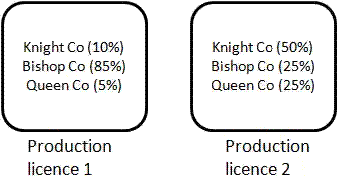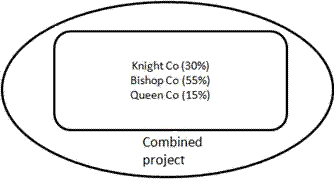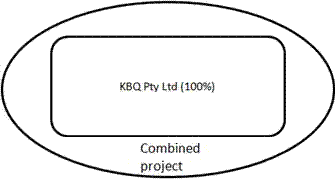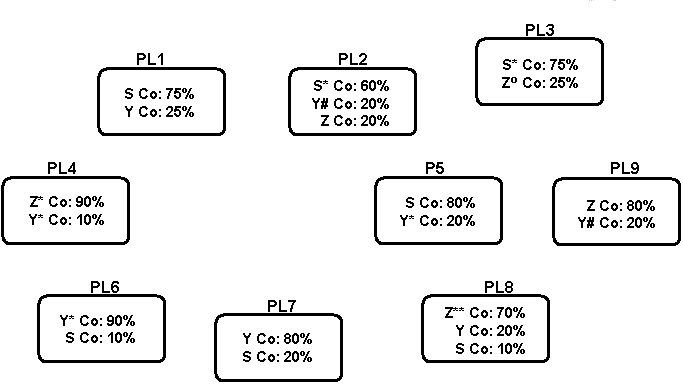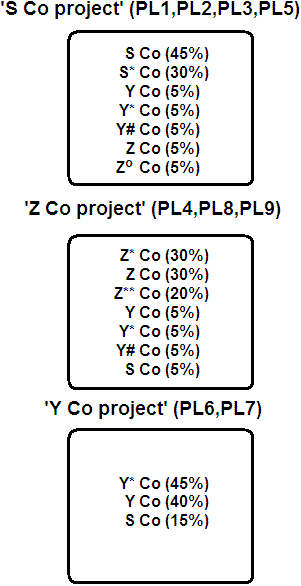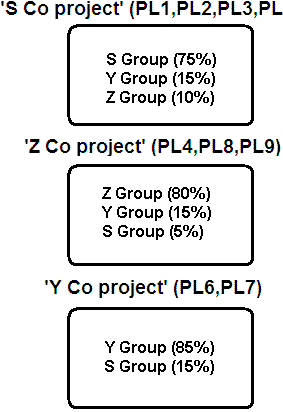Explanatory Memorandum
(Circulated by the authority of the Deputy Prime Minister and Treasurer, the Hon Wayne Swan MP)Chapter 6 - Consolidated groups
Outline of chapter
6.1 This chapter outlines the provisions in Schedule 5 to the Petroleum Resource Rent Tax Assessment Amendment Bill 2011 (Main Bill), which amend the Petroleum Resource Rent Tax Assessment Amendment Act 1987 (PRRTAA 1987) to provide for certain groups of entities that have formed a consolidated group for income tax purposes to also choose to consolidate for Petroleum Resource Rent Tax (PRRT) purposes.
6.2 A PRRT consolidated group has lower compliance costs because it is treated as a single entity for PRRT purposes in relation to onshore petroleum projects.
6.3 All legislative references throughout this chapter are to the Main Bill unless otherwise indicated.
Context of amendments
6.4 Currently, taxpayers are unable to consolidate interests they hold within a PRRT project. Although there is scope to transfer within a group some eligible exploration expenditure (see Division 3A of the PRRTAA 1987), this does not extend to other elements of the PRRT, such as amounts of general expenditure or assessable receipts.
6.5 One result of this is that even though a group of entities with interests in the same PRRT project may share the same owners, and be consolidated for income tax purposes, each entity needs to separately account for PRRT.
6.6 For participants in offshore projects, this has not been a major issue in practice. An offshore project usually involves only a small number of discrete participants, with each participant's interest held by a single entity. In these circumstances, there has been no need to provide for consolidation within the PRRT.
6.7 However, the present structure of the onshore oil and gas industry is very different to the offshore industry. In particular there is a broader range of participants and many more instances where an economic entity's interests in a PRRT project are held across a range of wholly-owned subsidiaries.
6.8 Applying the current law to such taxpayers could mean they are faced with large compliance burdens, as they would be required to account for the PRRT separately for each of their entities, across each of the projects in which they have an interest. In turn, this would place a high burden on the administrators of the PRRT, for no substantive benefit, including the amount of tax payable over time.
6.9 In some cases it would be possible for PRRT taxpayers to reduce their compliance costs under the existing provisions, by consolidating their separate interests into a single entity (sections 48 and 48A of the PRRTAA 1987 describe how these transactions would be treated for PRRT purposes). However, such an approach would involve its own costs, such as the imposition of duties and transfer fees, and may be subject to contractual and commercial impediments, particularly where a licence is held by multiple parties.
6.10 To avoid these costs, the PRRT law is amended to allow a corporate group with multiple interests in an onshore petroleum project to consolidate those interests in a single entity.
6.11 This change is intended to simplify compliance with (and the administration of) the PRRT, and not to otherwise alter its operation. For example, allowing consolidation does not alter the project based nature of the PRRT or affect the operation of the rules governing project combinations (see Chapter 2).
Summary of new law
Consolidated groups
6.12 A group of Australian resident entities that is a consolidated group or a multiple entry consolidated group (MEC group) [1] for income tax purposes can choose to consolidate for PRRT purposes. It must notify the Commissioner of Taxation (Commissioner) of its decision to do so.
6.13 Consolidation under the PRRT applies only to onshore project interests. It does not apply to interests in offshore projects.
6.14 A PRRT consolidated group is treated as a single entity, so that the group's onshore project interests are treated as being those of the head company of the group. However, the members of the group will be jointly and severally liable for paying the head company's PRRT liabilities if the head company does not pay them.
6.15 An entity that joins a PRRT group (when the group forms or because it is acquired by the group) is treated as having transferred its project interests to the head company of the group. For PRRT purposes, when an entity leaves a consolidated group, the head company is treated as having transferred to it the interests (and parts of interests) the entity takes with it.
6.16 Changes in a group's head company, and certain conversions from a MEC group to a consolidated group (and vice versa), lead to roll-overs under which the PRRT treatment that applied to the old head company is inherited by the new head company, ensuring a continuity of treatment for the group.
Comparison of key features of new law and current law
| New law | Current law |
| A group of entities that is consolidated for income tax purposes can choose to consolidate for PRRT purposes.
This allows group companies who are participants in the same onshore project (including a combined project) to be effectively treated as a single company for the PRRT. |
Each entity must account for its interest in a petroleum project separately, even where there is wholly common ownership.
Certain exploration expenditure is transferable between entities sharing common ownership. |
Detailed explanation of new law
Consolidated groups
6.17 Wholly-owned company groups have been able to consolidate for income tax purposes since 2002. The broad effect of consolidating is that the group is treated as a single entity, with all the assets, liabilities and activities of the group treated as belonging to the head company for income tax purposes, rather than to the various entities in the group that actually own those assets or conduct those activities. The effect is that intra-group transactions are ignored for income tax purposes, reducing the group's tax compliance costs.
6.18 The PRRT consolidation rules reduce a group's compliance costs by treating the members of the group holding interests in onshore petroleum projects as a single entity for PRRT purposes in relation to onshore petroleum projects. [Schedule 5, item 1, subsection 58P(1) of the PRRTAA 1987]
Effects of consolidating for PRRT purposes
6.19 Subsidiary members of a consolidated group, or a MEC group, that has chosen to consolidate for PRRT purposes, are treated as being parts of the group's head company (rather than separate entities) for these PRRT purposes:
- •
- working out the interests in onshore petroleum projects the entities have;
- •
- working out assessable receipts and deductible expenditure arising in relation to those interests; and
- •
- working out the PRRT payable in relation to those interests.
[Schedule 5, item 1, subsection 58P(2) of the PRRTAA 1987]
6.20 This means that all the onshore petroleum project interests of the group are treated as being the interests of the head company. If an interest is transferred between two entities in the group, the transfer is ignored for PRRT purposes in the same way it would be if any single entity reorganised the management of its interests.
Example 6.1: The 'single entity' rule
Knight Gas Co, Bishop Gas Co and Queen Gas Co are subsidiaries of KBQ Pty Ltd. They have formed a consolidated group for income tax purposes and choose to form one for PRRT purposes.
Knight, Bishop and Queen each have a 30 per cent interest in a combined onshore project (an unrelated party has the remaining 10 per cent). Due to the effect of the single entity rule, these interests, including the assessable receipts and deductible expenditure in relation to them, are treated as being those of KBQ Pty Ltd and not of the subsidiary companies.
6.21 When a group consolidates for PRRT purposes, all the onshore petroleum project interests of the group's subsidiary members are treated as having been transferred to the head company of the group. [Schedule 5, item 1, section 58Q of the PRRTAA 1987]
6.22 The effect of this transfer is described by existing provisions in the PRRT law (see section 48 of the PRRTAA 1987). Broadly, these provisions ensure that when a project interest is transferred between taxpayers, the associated history of assessable receipts and deductible expenditure is also transferred.
Example 6.2: Transfer of interests to head company
Knight Gas Co, Bishop Gas Co and Queen Gas Co are the same subsidiaries of KBQ Pty Ltd discussed in Example 6.1.
On 1 July 2012, when the PRRT first applies to onshore gas projects, the companies have interests in two adjacent onshore production licences. Initially, a PRRT project will exist in respect of each of these production licences. This would require KBQ to maintain six sets of PRRT accounts (three for each project), even though it has a 100 per cent interest in each project, and the projects are closely related, including in that the gas from both licence areas is sent to the same processing facility.
Shortly after 1 July 2012, the companies apply to the Resources Minister for the two projects to be combined, given their close relationship to each other. Having regard to the factors set out in section 20 of the PRRTAA 1987 (as amended, see Chapter 2), the Resources Minister agrees to combine the two production licences into a single PRRT project.
Combining the two projects allows each of Knight Co, Bishop Co and Queen Co to keep only one set of PRRT accounts in relation to this project. But unless the companies consolidate for PRRT purposes, KBQ is still required to treat each company as a separate PRRT taxpayer.
However, KBQ now chooses to consolidate the group for PRRT purposes. This means that the interests of the subsidiary companies in relation to this project are all treated as having been transferred to the head company, KBQ. It is now treated under the PRRT as having a 100 per cent interest in this project, including all of the history of assessable receipts and deductible expenditure inherited from its subsidiaries. Knight Co, Bishop Co and Queen Co are taken to no longer have an interest in this PRRT project, and so no longer need to separately account for their PRRT expenditure and receipts.
Example 6.3: Consolidation works within the PRRT's design as a project-based tax
The diagram below illustrates the interests that three corporate groups have in several onshore production licences across a region of New South Wales. Each of the three corporate groups is a consolidated group for income tax purposes comprising a number of separate legal entities.
The S Co group comprises S Co and S* Co.
The Y Co group comprises Y Co, Y* Co and Y# Co
The Z Co group comprises Z Co, Z* Co, Z** Co and Zo Co
Initially, there are nine projects in this region, one for each production licence. Each entity must account for PRRT for each project, a total of 20 PRRT returns.
Each of the groups seeks to combine those projects in which it is entitled to more than 50 per cent of the project assessable receipts (see subsection 20(4) of the PRRTAA 1987). S Co group is able to apply to combine PL1, PL2, PL3 and PL5 into a single project. Y Co group can apply to combine PL6 and PL7, and Z Co group can seek to combine PL4, PL8 and PL9.
Whether these projects are sufficiently related to warrant being combined is a matter for the Resources Minister, having regard to the factors set out in subsection 20(1) of the PRRTAA 1987. It makes no difference for the purpose of combining projects whether or not any of the groups are consolidated.
Assuming that the Minister determines the projects should be combined, the nine original projects will no longer exist, and will be replaced by three combined projects.
Although the number of projects has decreased from nine to three, because each separate entity for each project must account for PRRT separately, there are still 17 PRRT taxpayers across this region.
If each of the S Co, Y Co and Z Co groups now choose (and are able) to consolidate for PRRT, then all of the interests in each project are treated as transferred to the head company of each group (which may be one of the entities already with an interest in the project, but does not need to be).
The result is that each group is treated as a single PRRT taxpayer for each project in which it has an interest. However, each group continues to need to account for the PRRT on a project-by-project basis. For example, S Group's 75 per cent interest in the top project cannot be merged with its interests in the other two projects.
Example 6.4: Only onshore project interests are transferred to the head company
Rook Co and Pawn Co are both part of the same income tax consolidated group. Beak Co is the head company of this group and chooses to consolidate for PRRT purposes.
Immediately before this choice is made, Rook Co and Pawn Co have the following interests in petroleum projects:
Onshore project PL1: Rook Co (75 per cent), Pawn Co (25 per cent);
Onshore project PL2: Rook Co (25 per cent), Pawn Co (25 per cent), and an unrelated party (50 per cent);
Offshore project PL3: Rook Co (50 per cent), Pawn Co (50 per cent).
The effect of the PRRT consolidation is that Rook Co's and Pawn Co's interests in the onshore projects (PL1 and PL2) are transferred to the group head company, Beak Co. The offshore project interests are not transferred to the head company, and remain with the subsidiary companies.
After the consolidation takes effect, Beak Co will have a 100 per cent interest in PL1 and a 50 per cent interest in PL2. Rook Co and Pawn Co each has a 50 per cent interest in PL3.
Choosing to consolidate for PRRT purposes
6.23 A group can choose to consolidate for PRRT purposes if it is an income tax consolidated group or MEC group. [Schedule 5, item 1, subsection 58N(1) of the PRRTAA 1987]
6.24 It must also have previously notified the Commissioner that it has consolidated for income tax purposes. This allows the Commissioner to verify that the group is eligible to consolidate for PRRT purposes. [Schedule 5, item 1, subsection 58N(2) of the PRRTAA 1987]
6.25 After it chooses to consolidate for PRRT purposes, the group's head company (or provisional head company in the case of a MEC group) must give the Commissioner notice of the choice in the approved form within 21 days (or within such further time as the Commissioner allows). This is different from the position for income tax law (where the choice is notified with the year's income tax return) because of the interaction of the PRRT instalments system and the PRRT consolidation rules. [Schedule 5, item 1, subsection 58N(3) of the PRRTAA 1987]
6.26 The choice has effect on the day it was made and continues to have effect for as long as the group exists. [Schedule 5, item 1, subsection 58N(4) of the PRRTAA 1987]
6.27 There are some cases where a group technically ceases to exist because it is converted into a different sort of group. This is the situation with a MEC group that becomes a consolidated group (see section 703-55 of the Income Tax Assessment Act 1997 (ITAA 1997)) and with a consolidated group that becomes a MEC group (see section 719-40 of the ITAA 1997). A choice to consolidate for PRRT purposes, made before such a conversion, continues to have effect, despite the group technically ceasing to exist in those cases, because the head company of the group after the conversion inherits the history of things done by the head company before the conversion. [Schedule 5, item 1, section 58V of the PRRTAA 1987]
6.28 A choice to consolidate for PRRT purposes, once made, cannot be unmade and cannot be altered. [Schedule 5, item 1, subsection 58N(4) of the PRRTAA 1987]
Joining and leaving a consolidated group
Joining a group
6.29 Entities can join a consolidated group or MEC group in two broad ways. They can join when the group forms or they can join when the group acquires the entity some time after the group is formed. Complex allocable cost amount calculations can be involved for income tax purposes when an entity joins a consolidated group because the cost bases of assets the entity brings with it are reset to reflect the economic cost of the joining entity to the group. Those calculations do not apply for PRRT purposes when an entity joins a group.
6.30 Instead, when an entity joins a group (whether because the group is formed or because the group acquires the entity), it is treated as transferring its interests in onshore petroleum projects to the group's head company. [Schedule 5, item 1, section 58Q of the PRRTAA 1987]
6.31 This includes transferring the history of deductible expenditure and assessable receipts the joining entity brings with it to the head company. Because expenditure is immediately brought to account under the PRRT regardless of whether it is of a capital or revenue nature, there is no need to revalue assets or estimate their remaining effective lives for depreciation purposes, as is the case under income tax. [Schedule 5, item 1, section 58Q of the PRRTAA 1987]
6.32 The joining entity remains liable for PRRT liabilities that arose in relation to the transferred interest before the transfer year.
Leaving a group
6.33 When an entity leaves a PRRT consolidated group, the head company is treated as transferring to the leaving entity the interests (and part interests) it takes with it. [Schedule 5, item 1, section 58R of the PRRTAA 1987]
6.34 This notional transfer is governed by the same rules as currently apply when an interest (or part interest) is actually transferred between different taxpayers (see sections 48 and 48A of the PRRTAA 1987).
6.35 Broadly, the effect of those rules is to allow the leaving entity to access the deductible expenditure (and to specify that it derives the assessable receipts) that comes with the transferred interests. When part of an interest is transferred, that same part of each class of the deductible expenditure of the total interest is transferred to the leaving entity.
Transferring from one group to another
6.36 When an entity leaves one consolidated group and joins another at the same time (that is, when one group acquires an entity from another group), the entity is treated as leaving its old group first and then joining its new group. This means that the transfer rules transfer the old group's interests to the leaving entity before transferring them from that entity to the head company of the group it has joined. [Schedule 5, item 1, section 58S of the PRRTAA 1987]
Roll-over rules
6.37 A number of 'roll-over' rules apply under the income tax consolidation provisions to deal with certain changes to a group. Their broad effect is to ensure that the treatment the group had before the change applies to the group after the change, so that there is a continuity of treatment for the group. A number of rules achieve the same result for the purposes of the PRRT.
Changing the head company of a consolidated group
6.38 When the head company of a consolidated group changes, the new head company can choose to treat the consolidated group as continuing in existence (see subsection 124-380(5) of the ITAA 1997). The income tax consequence is that the group is taken not to have ceased to exist and everything that happened in relation to the old head company is taken to have happened instead to the new head company (see sections 703-70 and 703-75 of the ITAA 1997).
6.39 If a group makes the choice under subsection 124-380(5) of the ITAA 1997, identical results apply to the group for relevant PRRT purposes as apply for income tax purposes. The group is taken to continue to exist and the new head company inherits the relevant history from the old head company, just as if the new head company had been the old head company at all relevant times. The old head company becomes a subsidiary member of the group from the time of the changeover. [Schedule 5, item 1, section 58T of the PRRTAA 1987]
Changing the head company of a MEC group
6.40 Whenever there is a change in the head company or provisional head company of a MEC group, the income tax consequence is that everything that happened in relation to the old head company is taken to have happened to the new head company. This ensures the continuity of the group's treatment despite the change in its head company (see sections 719-75 and 719-90 of the ITAA 1997).
6.41 The same result applies under the PRRT law when there is a change in the head company or provisional head company of a MEC group. For the relevant PRRT purposes, the new head company (or provisional head company) inherits the history from the old head company (or provisional head company) just as if the new head company had been the old head company at all relevant times. The old head company (or provisional head company) becomes a subsidiary member of the group from the time of the changeover. [Schedule 5, item 1, section 58U of the PRRTAA 1987]
Application and transitional provisions
Consolidation
6.42 A group can make a decision to consolidate for PRRT purposes at any time after it satisfies the pre-conditions (including the requirement that it already be consolidated for income tax purposes). The decision applies from the date on which the group makes that choice.
Consequential amendments
Notes about the link between income tax and PRRT consolidation
6.43 Some notes are added to the consolidation provisions in the income tax law to alert readers to that fact that a choice to consolidate a group for income tax purposes is a prerequisite for it to consolidate for PRRT purposes. [Schedule 5, items 2 and 3, subsections 703-50(1) and 719-50(1) of the ITAA 1997]
Joint and several liability
6.44 Under the income tax law, income tax liabilities are imposed on the head company of a consolidated group or MEC group. However, the members of the group are jointly and severally liable for paying those liabilities if the head company does not pay them on time (see Division 721 of the ITAA 1997).
6.45 The tax-related liabilities for which the members can be jointly and severally liable are listed in the table in subsection 721-10(2) of the ITAA 1997.
6.46 That table is amended so that the tax-related liabilities include liabilities arising under the PRRT law. The relevant PRRT liabilities are:
- •
- the liability to pay PRRT itself;
- •
- the liability for shortfall interest charge on unpaid PRRT;
- •
- the liability for paying PRRT instalments; and
- •
- the instalment transfer interest charge that applies when a head company chooses too low an instalment rate.
[Schedule 5, item 4, subsection 721-10(2) of the ITAA 1997]
6.47 The members of a consolidated group or a MEC group only become jointly and severally liable for those PRRT liabilities if the group has chosen to consolidate for PRRT purposes. [Schedule 5, item 5, subsection 721-10(5) of the ITAA 1997]
6.48 The result is that Division 721 of the ITAA 1997 applies to impose joint and several liability in relation to PRRT liabilities on the members of a group that has consolidated for PRRT purposes in the same way as it does for the other liabilities listed in that table.
Definitions in the PRRTAA 1987
6.49 These consolidation rules add to the PRRT law several terms with specific meanings elsewhere in the tax law. Accordingly, the meaning of these terms is added to the list of definitions in section 2 of the PRRTAA 1987.
6.50 The terms 'consolidated group', 'MEC group', 'provisional head company' and 'subsidiary member' all have the same meaning in the PRRT law as they do in subsection 995-1(1) of the ITAA 1997. [Schedule 5, items 6, 9, 11 and 12, section 2 of the PRRTAA 1987]
6.51 The terms 'created' and 'member' have the same meaning they do in relation to consolidated groups and MEC groups as they do in the ITAA 1997. [Schedule 5, items 7 and 10, section 2 of the PRRTAA 1987]
6.52 The term 'head company' is already used in the PRRTAA 1987- essentially it means the head company of a 'designated company group', the concept which is currently used to define the eligibility for transfers of exploration expenditure.
6.53 The new definition of 'head company' retains this meaning, and also means the same thing as it does in the ITAA 1997, in relation to consolidated groups and MEC groups. [Schedule 5, item 8, section 2 of the PRRTAA 1987]

